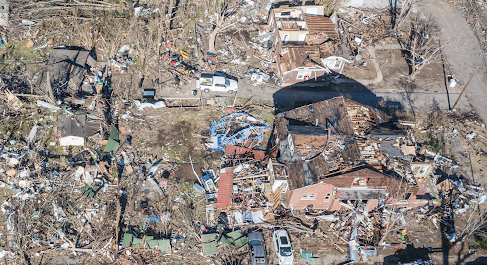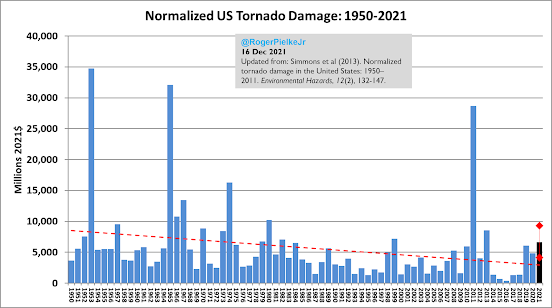
As I will demonstrate below, these claims are contradictory to the best science and at odds with respected international and national scientific assessments. Many are based on simplistic arguments that demonstrate a lack of understanding of the ingredients required for severe convection (thunderstorms) or evince a lack of knowledge of the historical record.
Have Strong Tornadoes Been Increasing in the U.S.?
The very first question one must ask when evaluating the role of global warming (or "climate change" as some folks prefer), is whether there is a trend. If global warming is contributing to severe tornado frequency or strength, one would expect an extended trend over decades.
Below you will see a plot of the frequency of strong tornadoes (EF 3, 4, 5) over time for the U.S. (and keep in mind that such strong tornadoes are pretty much limited to the Plains states and the SE U.S.) from the NOAA/NWS Storm Prediction Center. The trend is DOWNWARD towards fewer strong tornadoes. So if there is a trend to a "new normal" it is for LESS strong tornadoes.
Normalized tornado damage (which considers changes in changes in the cost of living and growth) is similar. No upward trend, downward if anything.
Some individuals are displaying the trend of all tornadoes over time, but this is problematic because we are now much more capable of observing the weakest tornadoes, many of which were missed 40 to 80 years ago.
The latest IPCC (Intergovernmental Panel on Climate Change) report states:
- "trends in tornadoes... associated w/ severe convective storms are not robustly detected"
- "attribution of certain classes of extreme weather (eg, tornadoes) is beyond current modeling and theoretical capabilities"
- "how tornadoes... will change is an open question"
"Observed trends and projections of future changes in severe thunderstorms, tornadoes, hail, and strong wind events are uncertain."
Claims Unsupported By Science or Data
- Strong atmospheric instability is essential, with temperature declining rapidly with height.
- A large change in wind with height (wind shear) is critical, both for allowing storms to become intense and to produce the rotation in supercell thunderstorms, the parents of most severe tornadic events.
- And one needs upward motion or lift to release the instability, and this can be from a strong front or an upper-level trough or jet streak.
And there are more requirements I won't go into here.
Simply warming the surface is not enough to enhance severe thunderstorm development.
Good evidence for this is provided by a map showing the climatology of tornadoes around the planet. Tornadoes are infrequent in the warm, humid tropics, where large and frequent thunderstorms are noted. Essential ingredients are missing.
So claims that warming will produce more severe tornadic thunderstorms should be taken with a big grain of salt...severe tornadic thunderstorms depend on an array of requirements, some of which could well weaken under global warming
Finally, let me note that even the local warming claims have issues. For example, we are in a moderate La Nina year, which produces warmer than normal conditions over the southeast U.S. Blaming all of it on global warming is problematic.
The Bottom Line
Claims that the severe tornadoes experienced last Friday evening were the result of global warming/climate change have little basis in the scientific literature or meteorological observations. Observed trends contradict the claims. No such conclusions have been made by the leading scientific groups (e.g., the IPCC).
Unfortunately, it is a potent example of the politicization of weather and climate, which leads to fearful populations and a lack of action on key protective technologies, such as improved construction and better warnings.











This is a perfect example of government run amok - the head of FEMA has no experience with weather forecasting or anything else regarding meteorology, yet sees fit to make sweeping pronouncements about a subject in which her expertise is non - existent. Stay in your lane and focus on your actual job of helping victims of natural disasters, and stay out of obvious political entanglements.
ReplyDeleteIs there a good explanation for the decline in strong tornados since the early 80s?
ReplyDeleteThe arctic is warming up 2 to 3 times faster than the rest of north America. Given the strength of these systems is affected by the difference in temperatures, it would be expected the likelihood of strong tornadoes would decrease. Simple physics.
DeleteI'm afraid Cliff is going to be on the hook for one of these blogs after every significant weather event, no matter what the season, or what the event. Everything now gets related to climate change, which dilutes the message about its actual effects or when they will increasingly occur.
ReplyDeleteThis is interesting and may well be true. Overall climate warming and ocean acidification are still the most urgent problems of our age (barring nuclear war or a large asteroid on a collision course).
ReplyDeleteCliff: Your analysis is spot on.
ReplyDeleteCliff: Your analysis is spot on.
ReplyDeleteWith regard to "shifting" tornado alley, Fujita documented this decades ago. http://www.mikesmithenterprisesblog.com/2021/01/there-is-nothing-new-about-hypothesis.html
As someone who grew up in Indiana, I can tell you this. These can be dismissed as anomalies or explained away by science but that doesn't make it normal. Winter is not tornado season. I don't care what the white coats say.
ReplyDeleteOur world is changing and it's not going to be a good time.
Cliff doesn't want you to stress about it. But if we don't do something, future generations will judge us harshly. As they should.
as someone who grew up in Tornado Alley 60 miles west of Chicago, I can tell you this - the last major tornado that hit the Chicago area was back in the 70's - in January. I remember many times during my youth hearing the sirens going off in the Fall and Winter, and of course during the Spring. Your sweeping conclusions are incorrect and without any data justification.
DeleteSaw a NWS meteorologist on CNN being asked if the devastating tornados were caused by climate change. He said nope then when on to make the same arguments you have.
ReplyDeleteCNN is now well known for having two separate high level producers getting caught recently for being extremely inappropriate towards minors. Might be time to find a different channel for "news"
DeleteWhite Christmas for Bellingham??? Can't wait for Fridays podcast!
ReplyDeleteI’m hoping it’s for the puget sound lowlands as well. Haven’t had a white Christmas in a long time.
Deletei'd go as far as saying climate change contributed to the 'out-of-season' outbreak to the extent the low levels were warmer and moister than 'normal' for mid-DEC and like spring ... there was strong instability b/c temperatures aloft were cold ... and recent trends suggest winters starting and ending later.
ReplyDeleteI agree.
ReplyDeleteHow does the weakening magnetosphere impact weather patterns?
ReplyDeleteHi Cliff, something is going on with the weather in recent years. I've lived in Graham for 60 years and never had my thermometer hit 110 degrees or any thing close until this year.I don't remember day after day with wildfire smoke in my neighborhood until the last few years. Minnesota had it's 1st tornado in December last night in their history. If all this isn't related with global warming then please inform us of the cause.
ReplyDeleteWell, for the smoke the key thing is mismanagement of forests, human ignition, and invasive flammable plants. Don't need global warming for that. Winter tornadoes have occurred in the Midwest before. And a small portion of the heatwave last summer (1-2F) was probably global warming. Extreme weather and records don't require global warming.
DeleteCliff: You mentioned instability released by different factors, including a jet streak. What is a jet streak?
ReplyDeleteThanks for the analysis.
https://www.weather.gov/source/zhu/ZHU_Training_Page/winds/JetStream_Stuff/300_200_chart.htm
DeleteInflation adjusted S&P for the same period:
Deletehttps://www.multpl.com/inflation-adjusted-s-p-500
May I suggest going to http://www.ncdc.noaa.gov/billions/time-series and plotting severe (damage >$1b) windstorms by themselves. Annual #s stepped up 5x the prior baseline in 2008ff. In 2015, stepped to 7x.
ReplyDeleteThanks for the link. Note that it says: “ Caution should be used in interpreting trends based on this graphic for a variety of reasons. For example, inflation has affected our ability to compare costs over time. To reflect this, the graphic also shows events with less than $1 billion in damage at the time of the event, but after adjusting for inflation (Consumer Price Index), now exceed $1 billion in damages.
DeleteThe number and cost of disasters are increasing over time due to a combination of increased exposure (i.e., values at risk of possible loss), vulnerability (i.e., how much damage does the intensity (wind speed, flood depth) at a location cause) and that climate change is increasing the frequency of some types of extremes that lead to billion-dollar disasters (NCA 2018).”
Also note the cpi-adjusted S&P for the same time period:
https://www.multpl.com/inflation-adjusted-s-p-500
Is it unusual to have tornadoes in December?
ReplyDeleteDr Tim Ball - Historical Climatologist
ReplyDeleteBook: ‘The Deliberate Corruption of Climate Science’
Book: ‘Human Caused Global Warming, the Biggest Deception in History’
https://www.technocracy.news/dr-tim-ball-on-climate-lies-wrapped-in-deception-smothered-with-delusion/
https://www.youtube.com/watch?v=tPzpPXuASY8
One of the reasons I started following weather closely, ages ago, was because I'm an astronomy aficianado, and I was keenly interested in knowing when I might get a good glimpse at the sky. "Three telescopes, lots of waiting," I assure you! As someone who pays attention to where Mother Earth is in orbit, tilt, etc. it strikes me that most folks obsessed by climate (a very broad-brush matter) have little idea what the planet's relationship is to the Sun, and how much those mechanics (perhelion-aphelion, and tilt) affect planetary weather systems, grand scale. The N and S hemispheres, for example, differ greatly because the planet is actually closest to the Sun (perhelion) during WINTER (Jan). And that difference is appx five MILLION miles closer (lots of an energy difference). Earth's at it's farthest point in orbit (aphelion) in July, but we're tilted toward Ole Sol.
ReplyDeleteEarth's orbit is not - NOT - always the same, and not "perfect" as the Sun itself is moving through the cosmos. Pile on other mechanics that drive weather (like tides, currents, yada-yada) - get a grip on the massive complexity and scale of planetary motion before navel gazing "butterfly effect"(s). Just saying, from a planetary perspective I don't expect winters to be particularly calm, and heck if they've ever been the same (year to year).
I think cliff should talk more about the true effects of climate change rather what isn’t most of the time 🙂
ReplyDeletehttps://babylonbee.com/news/from-tornadoes-to-myocarditis-here-are-the-9-worst-effects-of-climate-change
ReplyDeleteHmm, looking at a yearly plot of tornadoes by year for December there is a clear uptrend (NOAA). And there is consensus that the average track for tornadoes has shifted east and north over time.
ReplyDeleteFrom Carbon Brief on the yearly number of severe tornadoes: "If only the strongest tornadoes are considered (F3-F5 or EF3-EF5), there is even weak evidence of a decline in numbers over the past few decades. However, experts warn against reading too much into an apparent decline in the number of severe tornadoes. They point out that the rating of strong tornadoes has not been consistent and that “early official records systematically rated tornadoes stronger” than those in the past three decades."
ReplyDelete